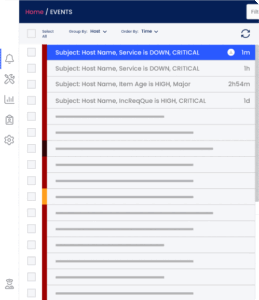There is a multitude of options on the market when it comes to open source and commercial monitoring platforms that are available for cloud management. It can be hard to sift through the various tools and come to an informed decision on what is the best fit for your team. In this article, we will explore the strengths and weaknesses of both open source and commercial tools and when each option is suitable for deployment.
Commercial or Open Source?
It is good to look at both of these options when you are considering choosing a type of software to implement. Both solutions have various pros and cons.
Open Source: Free, With Caveats
Advantages of Open Source Cloud Monitoring Tools
The biggest upside with open source is that it’s free and the only cost the user will incur (if any) from deploying it will be indirect as a result of needing to configure and maintain it. The user also avoids having extended meetings with vendors and the tiring negotiations with enterprise software companies. You download what you need and it’s ready to be deployed.
Another main benefit of using an open-source tool is that you have direct input on how the product matures over time. The vast majority (if not all) of open source products are community-driven, which means that any user can contribute to the code tree and make suggestions on how the product’s development goes. The downside to this is that you generally have to pay someone to do this for your business. It is a case then of whether your business can see an acceptable Return on Investment (ROI) to incur this expense and whether the added feature or upgraded software will pay off in the future.
Many open-source tools are created by engineers who began in commercial or open-source companies creating monitoring solutions but felt certain features were missing, so they developed an open-source tool to complement it. An example of this is Icinga, which was created and developed by developers from Nagios.
Disadvantages of Open Source Cloud Monitoring Tools
In general, the downside to open source is that it might not be as “mature” as commercially produced monitoring platforms. You will typically experience more problems with open source cloud monitoring tools and these problems will have to be dealt with by you. In order to solve these problems, either your team (usually DevOps or developers) will engage the community or you will hire a consulting company that’ll assist you with the distribution of open-source cloud monitoring tools.
In addition to dealing with more problems, upgrades/new features or bug fixes can take several months if not years to be released. This is because these fixes or upgrades are being provided by volunteers for free and therefore there is no set schedule. The lack of financial motivation behind any updates significantly slows down the timeline, in comparison to commercially produced offerings. In the commercial world, money talks and ensures that the provider updates software and fixes bugs as soon as possible or risks losing customers.
Examples of Open Source Cloud Monitoring Tools
Some examples of mature open-source cloud monitoring tools are Zabbix, Nagios, Icinga, and Zenoss. Zabbix and Nagios have been around for over 20 years and provide tried-and-true tools that are highly flexible in terms of data collection and configurations. Icinga offers more features than Nagios, which is why it was developed initially and is for those who don’t want to upgrade to the next level of Nagios. Zenoss is similar to Grafana with its cloud-focused monitoring, however, when compared to a product like Nagios it is limited in its functionality.
Commercial: Stability and Maturity at a Price
Commercial cloud monitoring platforms tend to be much more stable and more mature. When profit is concerned, it is not in the company’s best interest to release code that could cause their customers problems.
Advantages of Commercial Cloud Monitoring Tools
A poorly deployed and utilized cloud monitoring solution can severely damage a vendor’s brand, resulting in them losing a lot of business or even going to court.
This provides great motivation for the companies involved to produce quality, consistent products that work as promised because to do otherwise would hurt their business. In contrast to this, open-source providers ensure their users agree to terms and conditions that absolve the provider from any blame should problems occur.
Another advantage of a commercial product is the quality and level of support that you receive. There are great communities that provide good support in the open-source world. However, technical expertise is difficult to find there and you are conversing with technicians that are working with third-party software, not something they were involved in building.
Vendors also support their technology and this gives them another reason to ensure that their product works and is successful. They also have direct access to developers, experts, and project managers that can fix any problems or answer any technical questions a customer may have.
Downsides of Commercial Cloud Monitoring Tools
The main downside to commercial monitoring management tools is the price. Commercial cloud monitoring platforms are not free. The price could also go up significantly as product usage increases and when the customer would like to use more and more features.
Another downside is that while open source monitoring solutions are free, the parent companies that own the platform charge users if they require a higher level of support, like faster SLA and more advanced enterprise features. These open-source platforms also offer a paid commercial version with much more features.
Both open-source and commercial cloud monitoring tools incur costs and the decision is up to the user whether they want to pay the cost upfront for the commercial product or down the line for the open-source one.
Examples of Commercial Cloud Monitoring Tools
Examples of commercial cloud monitoring tools are New Relic, which is a cloud-based software that enables users to monitor mobile and web applications in real-time. Solarwinds is a server and application monitoring tool that offers end-to-end monitoring anywhere, which makes it perfect for on-premises and cloud services. Finally, Datadog cloud monitoring is a simple cloud monitoring that has an elegant interface and simplifies complex data points through its advanced filtering.
Also, there are many popular combinations of monitoring platforms, such as Grafana and Prometheus, which are good monitoring solutions for those looking to gather and store metrics without hindering an application’s performance.
Conclusion
To decide which is the best option for your particular situation, you must first create a list of requirements that you need from the product. Only then can you truly consider the true cost of each of these choices.
The true cost is important here, as it refers to the entire amount of money that will be spent during the purchase and implementation of the product. Open-source tools might seem like the cheaper option because they are free. However, it is important to consider the price of installation, fixes, support, upgrades and other “hidden” costs. A lot of these costs will be incurred in labor, as your employees will need time to learn the software and how it works. These implementation costs are often ignored and can add up to a huge sum of money that was not previously taken into account. Commercial products have a higher up-front cost and this might be intimidating to companies that are unsure of their ROI on an investment like this.
Once these costs are acknowledged, the price gap between open source and commercial might not be as big as you first think. Open-source offerings often lack certain features that are generally included in commercial products, so be sure not to settle for the “free” option if there are certain features you need, as these could end up costing you even more money in the future to implement. However, open-source platforms do offer commercial versions with more features, so be sure to explore all available options.
The pros and cons of each option must be considered for your situation. Commercial monitoring platforms are not always the best option and there are many good reasons for organizations to choose open-source monitoring tools over commercial alternatives. The only way you will end up with the right tool for you is by focusing on what you need for your business and not the upfront price.
If you are searching for the best cloud monitoring tool to fit your specific needs, we have vast experience in advising and implementing various monitoring tools, both open-source and commercial, for diverse and complex environments.
Please Contact Us for more information!


